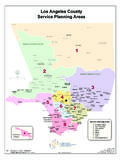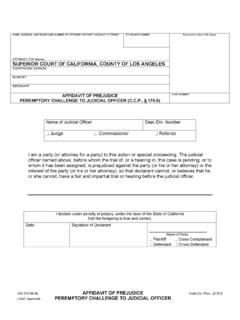Transcription of COUNTY OF LOS ANGELES OAK TREE ORDINANCE
1 COUNTY OF LOS ANGELES OAK tree ORDINANCE Established -- Purpose. The oak tree permit is established (a) to recognize oak trees as significant historical, aesthetic and ecological resources, and as one of the most picturesque trees in Los ANGELES COUNTY , lending beauty and charm to the natural and manmade landscape, enhancing the value of property, and the character of the communities in which they exist; and (b) to create favorable conditions for the preservation and propagation of this unique, threatened plant heritage, particularly those trees which may be classified as heritage oak trees, for the benefit of current and future residents of Los ANGELES COUNTY . It is the intent of the oak tree permit to maintain and enhance the general health, safety and welfare by assisting in counteracting air pollution and in minimizing soil erosion and other related environmental damage. The oak tree permit is also intended to preserve and enhance property values by conserving and adding to the distinctive and unique aesthetic character of many areas of Los ANGELES COUNTY in which oak trees are indigenous.
2 The stated objective of the oak tree permit is to preserve and maintain healthy oak trees in the development process. (Ord. 88-0157 1, 1988: Ord. 82-0168 2 (part), 1982.) Damaging or removing oak trees prohibited -- Permit requirements. A. Except as otherwise provided in Section , a person shall not cut, destroy, remove, relocate, inflict damage or encroach into a protected zone of any tree of the oak genus which is (a) 25 inches or more in circumference (eight inches in diameter) as measured four and one-half feet above mean natural grade; in the case of an oak with more than one trunk, whose combined circumference of any two trunks is at least 38 inches (12 inches in diameter) as measured four and one half feet above mean natural grade, on any lot or parcel of land within the unincorporated area of Los ANGELES COUNTY , or (b) any tree that has been provided as a replacement tree , pursuant to Section , on any lot or parcel of land within the unincorporated area of Los ANGELES COUNTY , unless an oak tree permit is first obtained as provided by this Part 16.
3 B. "Damage," as used in this Part 16, includes any act causing or tending to cause injury to the root system or other parts of a tree , including, but not limited to, burning, application of toxic substances, operation of equipment or machinery, or by paving, changing the natural grade, trenching or excavating within the protected zone of an oak tree . C. "Protected zone," as used in this Part 16, shall mean that area within the dripline of an oak tree and extending therefrom to a point at least five feet outside the dripline, or 15 feet from the trunks of a tree , whichever distance is greater. (Ord. 88-0157 2, 1988: Ord. 82-0168 2 (part), 1982.) Exemptions from Part 16 applicability. The provisions of this Part 16 shall not apply to: A. Any permit, variance or tentative map for a subdivision, including a minor land division, approved prior to the effective date of the ORDINANCE codified in this Part 16 by the board of supervisors, regional planning commission or the planning director; B.
4 Cases of emergency caused by an oak tree being in a hazardous or dangerous condition, or being irretrievably damaged or destroyed through flood, fire, wind or lightning, as determined after visual inspection by a licensed forester with the department of forestry 1and fire warden; C. Emergency or routine maintenance by a public utility necessary to protect or maintain an electric power or communication line or other property of a public utility; D. tree maintenance, limited to medium pruning of branches not to exceed two inches in diameter in accordance with guidelines published by the National Arborists Association, (see Class II), intended to insure the continued health of a protected tree ; E. Trees planted, grown and/or held for sale by a licensed nursery; F. Trees within existing road rights-of-way where pruning is necessary to obtain adequate line-of-sight distances and/or to keep street and sidewalk easements clear of obstructions, or to remove or relocate trees causing damage to roadway improvements or other public facilities and infrastructure within existing road rights-of-way, as required by the Director of Public Works.
5 (Ord. 93-0018 1, 1993; Ord. 88-0157 3, 1988; Ord. 82-0168 2 (part), 1982.) Application -- Filing -- Repeated filings. Any person desiring an oak tree permit, as provided for in this Title 22, may file an application with the director, except that no application shall be filed or accepted if final action has been taken within one year prior thereto by the hearing officer or director or the commission on an application requesting the same or substantially the same permit. (Ord. 85-0195 12 (part), 1985; Ord. 82-0168 2 (part), 1982.) Application -- Information and documents required. An application for an oak tree permit shall include the following information and documents: A. The name and address of the applicant and of all persons owning any or all of the property proposed to be used; B. Evidence that the applicant: 1. Is the owner of the premises involved, or 2. Has written permission of the owner or owners to make such application; C. Location of subject property (address or vicinity); D.
6 Legal description of the property involved; E. 1. A site plan drawn to a scale satisfactory to, and in the number of copies prescribed by the director, indicating the location and dimension of all of the following existing and proposed features on the subject property: a. Lot lines, b. Streets, highways, access and other major public or private easements, c. Buildings and/or structures, delineating roof and other projections, d. Yards, e. Walls and fences, f. Parking and other paved areas, g. Proposed areas to be landscaped and/or irrigated, h. Proposed construction, excavation, grading and/or landfill. Where a change in grade is proposed, the change in grade within the protected zone of each plotted tree shall be specified, i. The location of all oak trees subject to this Part 16 proposed to be removed and/or relocated, or within 200 feet of proposed construction, 2grading, landfill or other activity. Each tree shall be assigned an identification number on the plan, and a corresponding permanent identifying tag shall be affixed to the north side of each tree in the manner prescribed by Section These identifications shall be utilized in the oak tree report and for physical identification on the property where required.
7 The protected zone shall be shown for each plotted tree , j. Location and size of all proposed replacement trees, k. Proposed and existing land uses, l. Location of all surface drainage systems, m. Other development features which the director deems necessary to process the application, 2. Where a concurrent application for a permit, variance, zone change, tentative map for a subdivision, including a minor land division or other approval, is filed providing the information required by this subsection E, the director may waive such site plan where he deems it unnecessary to process the application; F. 1. An oak tree report, prepared by an individual with expertise acceptable to the director and COUNTY forester and fire warden, and certified to be true and correct, which is acceptable to the director and COUNTY forester and fire warden, of each tree shown on the site plan required by subsection E of this section, which shall contain the following information: a. The name, address and telephone number during business hours of the preparer, b.
8 Evaluation of the physical structure of each tree as follows: i. The circumference and diameter of the trunk, measured four and one-half feet above natural grade, ii. The diameter of the tree 's canopy, plus five feet, establishing the protected zone, iii. Aesthetic assessment of the tree , considering factors such as but not limited to symmetry, broken branches, unbalanced crown, excessive horizontal branching, iv. Recommendations to remedy structural problems where required, c. Evaluation of the health of each tree as follows: i. Evidence of disease, such as slime flux, heart rot, crown rot, armillaria root fungus, exfoliation, leaf scorch and exudations, ii. Identification of insect pests, such as galls, twig girdler, borers, termites, pit scale and plant parasites, iii. Evaluation of vigor, such as new tip growth, leaf color, abnormal bark, deadwood and thinning of crown, iv. Health rating based on the archetype tree of the same species, v. Recommendations to improve tree health, such as insect or disease control, pruning and fertilization, d.
9 Evaluation of the applicant's proposal as it impacts each tree shown on the site plan, including suggested mitigating and/ or future maintenance measures where required and the anticipated effectiveness thereof, e. Identification of those trees shown on the site plan which may be classified as heritage oak trees. Heritage oak trees are either of the following: any oak tree measuring 36 inches or more in diameter, 3measured four and one-half feet above the natural grade; any oak tree having significant historical or cultural importance to the community, notwithstanding that the tree diameter is less than 36 inches, f. Identification of any oak tree officially identified by a COUNTY resource conservation district. 2. The requirement for an oak tree report may be waived by the director where a single tree is proposed for removal in conjunction with the use of a single-family residence listed as a permitted use in the zone, and/or such information is deemed unnecessary for processing the applications; G.
10 The applicant shall provide an oak tree information manual prepared by and available from the forester and fire warden to the purchasers and any homeowners' association. (Ord. 88-0157 4, 1988: Ord. 82-0168 2 (part), 1982.) Application -- Burden of proof. A. In addition to the information required in the application by Section , the application shall substantiate to the satisfaction of the director the following facts: 1. That the proposed construction of proposed use will be accomplished without endangering the health of the remaining trees subject to this Part 16, if any, on the subject property; and 2. That the removal or relocation of the oak tree (s) proposed will not result in soil erosion through the diversion or increased flow of surface waters which cannot be satisfactorily mitigated; and 3. That in addition to the above facts, at least one of the following findings apply: a. That the removal or relocation of the oak tree (s) proposed is necessary as continued existence at present location(s) frustrates the planned improvement or proposed use of the subject property to such an extent that: i.




